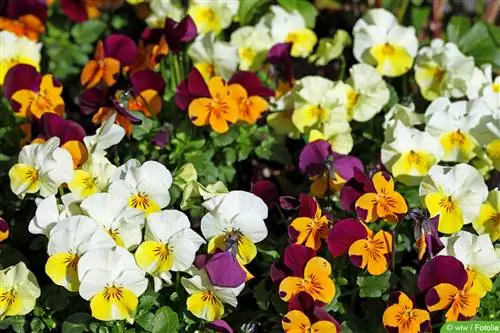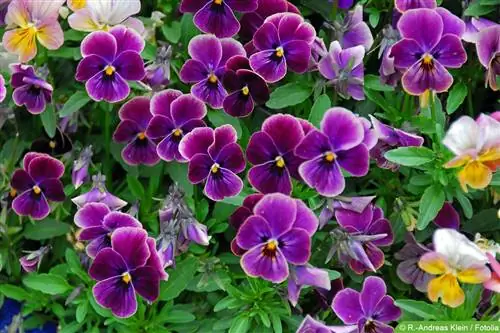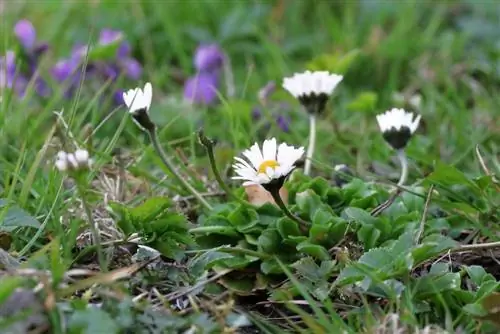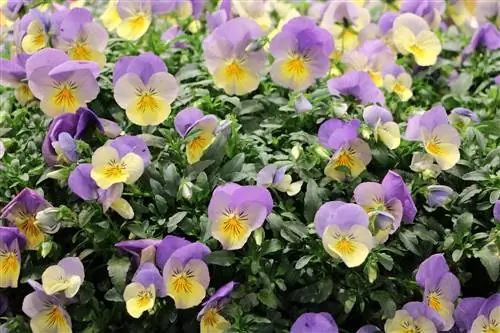- Author admin [email protected].
- Public 2023-12-17 03:39.
- Last modified 2025-01-24 12:45.
So that the horned violets survive the frost unscathed, the time of planting is important. The flowers must have enough time to take root in the ground. Only hybrid breeds that can tolerate low temperatures are hardy.
variety selection
There are different species in the trade that are called horned violets. Basically, Viola cornuta and Viola wittrockiana are suitable for overwintering. Both species even prefer cooler temperatures and are frost-resistant down to -15°C. Both types are mainly planted in autumn so that the beds bloom lushly in spring.
There are now some varieties that have proven to be particularly frost-resistant. They are often sold in stores as “mini winter violets”. So far there are the following varieties that are particularly frost-resistant:
- Ice Babies
- Ice Teens
Note:
Regardless of whether they are planted in autumn or early spring, the flowers are usually replaced in summer, as they then hardly bloom anymore or, once they have formed seeds, die.
Planting time
Regardless of the variety, the right time to plant is. Planting in September or October is ideal. If you cannot use this time window, February or March is also an option to plant the flowers. However, if you want to plant in early spring, make sure you take advantage of a sustained warm period. It should be warm for at least a week so that the plants have enough time to take root in the ground.

Winter preparation
A little winter preparation helps the plants get through the cold season. Through proper winter preparation, plants save energy and are less susceptible to frost.
Tips for winter preparation:
- Removing flowers and buds
- remove dead leaves and shoots
- incorporate a tablespoon of horn shavings per plant
- Spread potash fertilizer generously
The potash fertilizer does not promote growth, but promotes the formation of a strong plant epidermis. This means the plants are not as susceptible to frost. Avoid heavy nitrogen fertilization as this would lead to increased shoot formation that is not frost-resistant. The plants would then freeze back severely and could even die completely.
Note:
If you plant the flowers in fresh potting soil, you can avoid horn shavings entirely. The substrate already has basic fertilization.
Frost protection optional
Horn violets can survive without winter protection, but at very low temperatures it is recommended to protect the plants. It is sufficient if the flowers are loosely covered. You can use both natural materials and commercially available winter protection for protection.
Suitable winter protection:
- Leaves
- Fir branches
- Winter fleece
Note:
Do not use walnut leaves or spruce branches. The falling needles or leaves can change the soil pH, making the substrate too acidic for the plants.
Take away the winter protection in good time. Mid-March is ideal, otherwise the ground cannot warm up in time. This would result in the flowers sprouting and blooming late.
Causes of frost damage
The so-called cold frost in particular can become a problem for the flowers. Plants that are not yet covered with snow and have been exposed to severe frost are at risk of dying completely. At very low temperatures it is therefore recommended that you cover the flowers.
If it snowed in winter, you can also spread a thick layer of snow loosely over the plants. A thick wall of snow takes longer to melt and the flowers are very well protected underneath. In addition, the soil stays moist longer, reducing the risk of drought in winter.
Note:
When overwintering outdoors, the water requirements of plants are often underestimated. Frost-free periods should always be used to water the plants sufficiently, even in beds.

horned violets in a pot
Horn violets in pots have a special place in winter. Although they are also frost-resistant, the way they are planted means that the root ball is at risk of being damaged by frost. The plants lack the warmth of the soil in the cold season.
Plants in pots should therefore be overwintered appropriately. One option is to place them in an unheated greenhouse. You can also protect the plants with a winter fleece. Alternatively, you can simply bury the pots in the ground. Make sure that the soil in the planter is flush with the ground.
Beware of winter wetness
Another problem with horned violets in pots is winter wetness. Although it is important to water during frost-free periods, it can happen that the plants are too wet, especially when it starts to thaw. In this case, the roots can rot and the plants die.
To prevent this from happening, you should plant the flowers correctly:
- Pot must have at least one drainage hole
- bottom layer forms a drainage made of expanded clay or lava granules
- Mix substrate 1/3 with expanded clay or lava granules
Make sure to remove excess water, even in the winter months. In addition to the time after watering, you should also check the saucers when there is an extended frost-free period. The condensation water can collect in the saucer and also promote rot.






